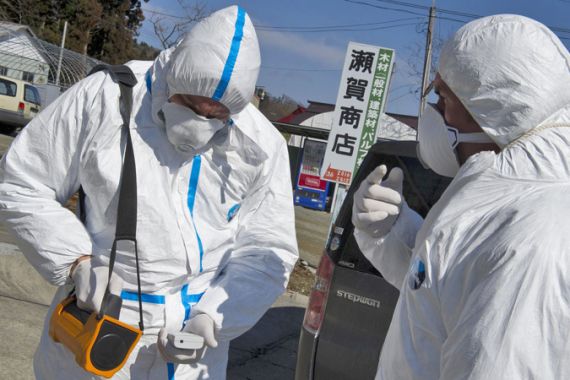Engineers toil against radiation in Japan
Levels of radioactive iodine in seawater 30km from Fukushima nuclear plant have spiked 1,250 times higher than normal.

Japanese engineers have struggled to pump radioactive water from a crippled nuclear power station after radiation levels soared in seawater near the plant more than two weeks after it was battered by a huge earthquake and a tsunami.
Engineers trying to stabilise the plant had to pump out radioactive water on Sunday after it was found in buildings housing three of the six reactors.
Keep reading
list of 4 itemsAfter the Hurricane
World’s coral reefs face global bleaching crisis
Why is Germany maintaining economic ties with China?
Tests on Friday showed iodine 131 levels in seawater 30 km from the coastal nuclear complex had spiked 1,250 times higher than normal, but it was not considered a threat to marine life or food safety, the Nuclear and Industrial Safety Agency said.
“Ocean currents will disperse radiation particles and so it will be very diluted by the time it gets consumed by fish and seaweed,” said Hidehiko Nishiyama, a senior agency official revealed.
Despite that reassurance, the disclosure is likely to heighten international concern over Japanese seafood exports.
The government has not told residents outside the 30 km radius of the plant to evacuate, or even to stay indoors.
No end in sight
Several countries have already banned milk and produce from areas around the Fukushima Daiichi plant, while others have been monitoring Japanese seafood.
Prolonged efforts to prevent a catastrophic meltdown at the 40-year-old plant have also intensified concern around the world about nuclear power.
Ban Ki-moon, the UN Secretary-General, said it was time to reassess the international atomic safety regime.
The crisis at the plant, 240 km (150 miles) north of Tokyo, has overshadowed a big relief and recovery effort from the magnitude 9.0 quake and the huge tsunami it triggered on March 11 that left more than 27,100 people dead or missing in northeast Japan.
On Thursday, three workers were taken to hospital from reactor Number 3 after stepping in water with radiation levels 10,000 times higher than usually found in a reactor. That raised fear the core’s container could be damaged.
An official from plant operator Tokyo Electric Power Co (TEPCO) said, “The radiation exposure on Thursday occured because there was bad sharing of information. We have to apologise. We want to make efforts to share information within the company.”
TEPCO told a Sunday news conference experts still had to determine where to put some of the contaminated water while engineers were still trying to fully restore the plant’s power.
And that it was using fresh water instead of seawater to cool down at least some of the reactors after concern arose that salt deposits might hamper the cooling process.
Two of the plant’s reactors are now seen as safe but the other four are volatile, occasionally emitting steam and smoke. However, the nuclear safety agency said on Saturday that temperature and pressure in all reactors had stabilised.
The government has said the situation was nowhere near to being resolved, although it was not deteriorating.
“We are preventing the situation from worsening – we’ve restored power and pumped in fresh water – and making basic steps towards improvement but there is still no room for complacency,” Yukio Edano, the chief cabinet secretary told a news conference on Saturday.
More than 700 engineers have been toiling in shifts but there’s no end in sight.
Impact on livelihoods
So far, no significant levels of radiation have been detected beyond the vicinity of the plant in Fukushima.
The US Department of Energy said on its website that no significant quantities of radiological material had been deposited in the area around the plant since March 19, according to tests on Friday.
In Tokyo, a metropolis of 13 million people, a Reuters reading on Saturday morning showed ambient radiation of 0.22 microsieverts per hour, about six times normal for the city. That was well within the global average of naturally occurring background radiation of 0.17-0.39 microsieverts per hour, a range given by the World Nuclear Association.
The government has prodded tens of thousands of people living in a 20 km-30 km zone beyond the stricken complex to leave. Edano said the residents should move because it was difficult to get supplies to the area, and not because of elevated radiation.
Radiation levels at the evacuation centre were within a normal range of about 0.16 microsievert, according to a Reuters geiger counter reading.
In Japan’s northeast, more than a quarter of a million people remain in shelters, and the impact on livelihoods is becoming clearer. The quake and tsunami not only wiped out homes and businesses but also a fishing industry that was the lifeblood of coastal communities.
“Fishermen lost their gear, ships and just about everything. About half will probably get out of the business,” said Yuko Sasaki, a fishmonger in the tsunami-hit city of Kamaishi.
The double disaster probably destroyed aqua farms for abalone, sea urchins, oysters, scallops and seaweed that authorities say account for 80 percent of the revenue of the region”s fisheries.
The tsunami obliterated centuries-old fishing ports along the northeast coast, sending ships adrift in the Pacific Ocean, to the bottom of the sea, or depositing them on land, where they now lie among the splintered remains of homes.